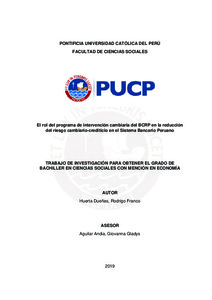| dc.contributor.advisor | Aguilar Andía, Gladys Giovanna | |
| dc.contributor.author | Huerta Dueñas, Rodrigo Franco | |
| dc.date.accessioned | 2020-12-04T01:05:25Z | |
| dc.date.available | 2020-12-04T01:05:25Z | |
| dc.date.created | 2019 | |
| dc.date.issued | 2020-12-03 | |
| dc.identifier.uri | http://hdl.handle.net/20.500.12404/17637 | |
| dc.description.abstract | Períodos prolongados de dolarización financiera pueden traer una serie de
distorsiones en la economía y nos vuelve especialmente susceptibles a choques
externos. Es por ello que resulta importante estudiar las acciones que toma el
BCRP para controlar los riesgos de un dólar muy protagonista, sobre todo en los
balances de los bancos. El objetivo principal de esta investigación es analizar la
relación existente entre las intervenciones cambiarias del BCRP y el riesgo
cambiario crediticio de las entidades bancarias en el período 1996-2018, sobre
todo determinar si las intervenciones ayudan a controlar y reducir este riesgo.
Como indicador de riesgo cambiario crediticio se emplea a la tasa de morosidad
en moneda extranjera, mientras que las intervenciones cambiarias se representan
mediante las operaciones que realiza el BCRP como la compra/venta de dólares
y la compra/venta de instrumentos derivados, diferenciando los efectos de las
compras del de las ventas. Además, subdividimos la muestra de bancos entre
“mayoristas” y “minoristas” para encontrar efectos diferenciados. La estimación la
realizamos con un Modelo de Datos de Panel Dinámico a lo Arellano y Bond, pues
tenemos datos de varios bancos individuales a lo largo de varios años. Los
resultados arrojan cosas interesantes. Primero, la relación del RCC con sus
determinantes siempre se da con rezago. Luego, hacer una distinción entre
bancos mayoristas y minoristas es importante y significativa: los minoristas sufren
de choques más fuertes de morosidad. Por último, las intervenciones cambiarias
no parecen explicar mucho del RCC, los otros determinantes macroeconómicos
resultan mucho más decisivos. | es_ES |
| dc.description.abstract | Long periods of financial dollarization can bring a series of distortions in the
economy and make us especially susceptible to external shocks. That is why it is
important to study the actions taken by the Peruvian Central Bank to control the
risks of a very powerful dollar, especially on the banks’ balance sheets. The main
objective of this paper is to analyze the relationship between the Peruvian Central
Bank exchange rate interventions and the exchange rate credit risk of banks in
the period 1996-2018 to determine if the interventions help to control and reduce
this risk. As an indicator of exchange rate credit risk, we use the Non-Performing
Loans Rate (default rate) in foreign currency, while foreign exchange interventions
are represented by the operations carried out by the BCRP such as the
purchase/sale of dollars and the purchase/sale of derivative instruments,
differentiating the effects of the purchases from the effects of the sales.
Furthermore, we subdivided the sample of banks between “Big Banks” and “Retail
Banks” to find differentiated effects. We estimated a Dynamic Panel Data Model
following Arellano and Bond’s methodology, since we have data from several
individual banks over several years. We got some interesting results. First, the
relationship of the exchange rate credit risk with its determinants always comes
with certain lag. Then, making a distinction between the banks is important and
significant: retailers suffer much more from stronger delinquency shocks. Finally,
the exchange rate interventions do not seem to explain much of the exchange rate
credit risk, the other macroeconomic determinants are much more decisive. | es_ES |
| dc.language.iso | spa | es_ES |
| dc.publisher | Pontificia Universidad Católica del Perú | es_ES |
| dc.rights | info:eu-repo/semantics/openAccess | es_ES |
| dc.rights.uri | http://creativecommons.org/licenses/by-sa/2.5/pe/ | * |
| dc.subject | Política monetaria--Perú | es_ES |
| dc.subject | Bancos centrales--Perú | es_ES |
| dc.subject | Bancos--Perú | es_ES |
| dc.subject | Tipos de cambio--Perú | es_ES |
| dc.subject | Finanzas--Perú | es_ES |
| dc.title | El rol del programa de intervención cambiaria del BCRP en la reducción del riesgo cambiario-crediticio en el Sistema Bancario Peruano | es_ES |
| dc.type | info:eu-repo/semantics/bachelorThesis | es_ES |
| thesis.degree.name | Bachiller en Ciencias Sociales con mención en Economía | es_ES |
| thesis.degree.level | Bachillerato | es_ES |
| thesis.degree.grantor | Pontificia Universidad Católica del Perú. Facultad de Ciencias Sociales | es_ES |
| thesis.degree.discipline | Ciencias Sociales con mención en Economía | es_ES |
| renati.advisor.dni | 8667305 | |
| renati.advisor.orcid | https://orcid.org/0000-0003-2031-5328 | es_ES |
| renati.author.dni | 77094725 | |
| renati.discipline | 311016 | es_ES |
| renati.level | https://purl.org/pe-repo/renati/level#bachiller | es_ES |
| renati.type | https://purl.org/pe-repo/renati/type#trabajoDeInvestigacion | es_ES |
| dc.publisher.country | PE | es_ES |
| dc.subject.ocde | http://purl.org/pe-repo/ocde/ford#5.02.01 | es_ES |






